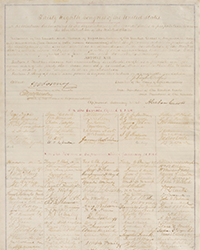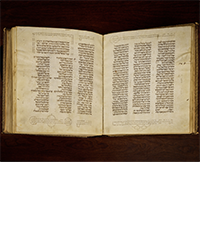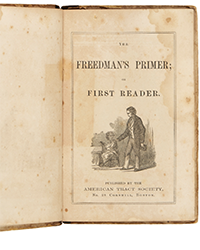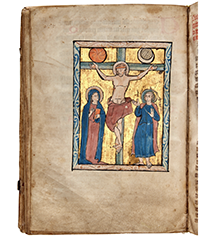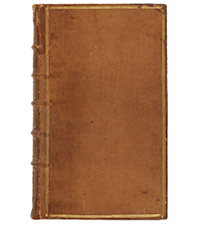Charles Wood Bookseller has issued Catalogue 194 of Early Photography. This is a collection of works from the early to the earliest days of photography, as far back as 1839. The process had barely been invented at that time, as different approaches were used by those trying to master the process sufficiently for practical use. Some of these books are about the photographic process while others used photographs in their earliest time. Many simply used mounted photographs then rather than trying to print them on a page. These are a few selections from this catalogue of early photography.
We begin with one of the earliest. While experimentation began in the 1820s, 1839 was the year in which announcements were being made of the earliest processes. Louis Daguerre presented his daguerreotype, while this publication introduced what was described by Henry Fox Talbot as “photogenic drawing.” Item 30 is the complete Volume XXXIII January 5, 1839 – June 29, 1939 of The Mirror of Literature, Amusement and Instruction. No. 945, April 20, 1839, contained A Treatise of Photogenic Drawing by Dr. Golding Bird. It includes a facsimile of one such “drawing,” that of a fern on a dark brown backing. The fern had been placed on sensitive photographic paper exposed to light, creating a negative, which in turn was used to create positives. It was sort of like what we now refer to as a contact print but made with the object rather than a negative. Bird's article explained the process. Priced at $4,500.
Considering that color photography was uncommon only a few decades ago, it might be surprising that it was created barely a decade after the development of black and white photography. The inventor was a minister from rural New York named Levi Hill. Hill was intrigued by photography and played around with various chemical processes when he chanced upon a formula in 1851 that could reproduce colors in photography. He described what he had done and showed off some pictures but refused to reveal his secret. There was much suspicion and some experts labeled him a fraud. They said he was hand-coloring his photographs. Finally, he revealed his work in this book, published in 1856: A treatise on heliochromy; or, the production of pictures by means of light, in natural colours. Embracing a full, plain, and unreserved description of the process known as the Hillotype, including the author's newly discovered collodio-chrome, or natural colours on collodionised glass. The name “Hillotype” followed that of Daguerreotype being named after its inventor. His book is rambling and the formula hard to follow, but many years later it was tested again and proved that it did actually produce color images though they were a rather washed-out looking colors. Item 17. $3,750.
At one time virtually every college and high school must have had yearbooks filled with pictures of students. They were practically guaranteed best sellers to their target audience, and the companies who produced these made a healthy profit. Who came up with this clever marketing idea? He was George K. Warren, an early photographer from Massachusetts who made daguerreotype portraits and scenes. For many years, he dominated the business. This is one of his earliest editions. It is for the Dartmouth College class of 1859, the second year he published one for them. It includes 52 salt print photographs of the graduates. Based on writing in the catalogue, Wood has been able to conclude this copy belonged to William Little. Most photos were either signed by the individual or their name annotated. Later annotations were also made, likely by Little, of what professions his classmates filled. Of A. J. Hersey, it says he was a deserter from the Confederate Army who became a Captain in the federal army. Others became lawyers, teachers, ministers and such, and some had already died. Item 12. $3,500.
There are only a handful of automobile makers left anymore, the field now being very mature. It wasn't always so. In the early 1900s, many entrepreneurs joined the fray along with the few that managed to survive the weeding process, Ford, General Motors, and Chrysler in America. Some of the defunct ones remain famous today – Pierce Arrow, Studebaker, Hupmobile, Stutz, Dusenberg, and Stanley Steamer. Others have been forgotten by almost everyone. One of those is the Moore Motor Vehicle Company, one of three different car manufacturers with Moore in its name. This Moore was formed in Minneapolis in 1916 by local Ford dealer George L. Moore. It later moved to Danville, Illinois, before going bankrupt and selling off its assets in 1920. It's one car was mid-priced, maybe on the high end of middle. They bragged about their “artistic lines,” best for a car in its price range, but perhaps they weren't the most objective source. Kimes is a bit more critical describing it as “a little horror with corners on the body sharp enough to cut your finger.” You can't please everyone. Are there any still around? If what is said about them, that they produced 600-1,000 cars, there must be, though I was totally unfamiliar with them before. Item 31 may be one of the best resources about this company still to be found. It is a company album of 25 photographs. Wood thinks it may have been created to entice investors. They show the car being demonstrated at the Minnesota State Fair, driving up a 47° incline, being dangled by its back from a Chicago office building (to demonstrate strength?), various views of the car and the plant, and a picture of company President Moore's office. $2,000.
There are a few catastrophic events so bad that they are remembered today, even if there is no one still living who witnessed them. One is the San Francisco Earthquake of 1906. This is another, the Great Chicago Fire of 1871. It raged for three days and by the end, hundreds of people had died and much of the city destroyed. Item 48 is Among the Ruins in Chicago, published circa 1872. It contains 12 cards of photographs of the aftermath. It is unclear whether this was a complete set or whether sets had different sizes or different photos. They are numbered with numbers ranging from 9 to 63. The photographer was George N. Barnard. Barnard had photographed a fire in 1853 of a grain elevator in Oswego, N.Y. It is considered one of the first news photographs. $2,400.
Charles Wood Bookseller may be reached at charles@cbwoodbooks.com or telephone 617-868-1711.


